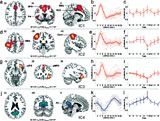Recent News
UNM joins Brown University in national institute focused on intuitive, trustworthy AI assistants
August 6, 2025
UNM Engineering team wins ASEE best paper for work on first-year engineering course
July 17, 2025
New director will enhance interdisciplinary engineering learning opportunities
July 2, 2025
Final SIRI cohort visits UNM campus
June 30, 2025
News Archives
Engage Brain Before Pushing Red Button
April 25, 2008
 Two of your brain's mental networks involved in performing cognitive tasks show measurable changes when you're about to make an error, according to ECE ProfessorVince Calhoun and his co-authors in an article published April 22 in Proceedings of the National Academy of Sciences.
Two of your brain's mental networks involved in performing cognitive tasks show measurable changes when you're about to make an error, according to ECE ProfessorVince Calhoun and his co-authors in an article published April 22 in Proceedings of the National Academy of Sciences.
Sometimes our brain is in a passive resting mode and sometimes it's in a focus mode. Problem is, the brain sometimes slips into resting mode, referred to as default mode, just before we perform a cognitive task. When such momentary lapses of attention happen, we're likely to make an error.
Calhoun's team has found a way to measure the error-predicting changes about 30 seconds before the error occurs.
Monitoring brain activity using fMRI image analysis immediately preceding errors, they found changes in two brain networks. "One network, the default mode, which is usually active at rest, slowly increased in the 30 seconds prior to an error," Calhoun says. "A second network, in the frontal lobe areas associated with sustaining effort and focus, decreased in activity prior to making an error. Hence the brain patterns associated with the resting brain became more active, whereas the regions involved in preventing this were less active."
According to the paper's abstract, "These maladaptive brain activity changes started to evolve ~30 sec before the error. In particular, a coincident decrease of deactivation in default mode regions of the brain, together with a decline of activation in regions associated with maintaining task effort, raised the probability of future errors."
In their abstract for the paper, the authors say that "Humans engaged in monotonous tasks are susceptible to occasional errors that may lead to serious consequences, but little is known about brain activity patterns preceding errors....Our findings provide insights into the brain network dynamics preceding human performance errors and suggest that monitoring of the identified precursor states may help in avoiding human errors in critical real-world situations."
The study data were collected by having participants respond as quickly as possible to arrows made visible briefly on a computer screen. The team used fMRI and applied independent component analysis followed by deconvolution of hemodynamic responses, which enabled them to study error-preceding brain activity on a trial-by-trial basis. The posterior medial frontal cortex was found to have reduced blood flow just before errors, while activity increased in the anterior medial frontal cortex, precuneus, and retrosplenial cortex area, or default mode network.
The researchers' work this week gained the attention of The Economist, The New York Times, Wired magazine, and the U.K's Daily Telegraph, among several others.
Their article, "Prediction of Human Errors by Maladaptive Changes in Event-Related Brain Networks," is available on PNAS' website here, or download a PDF of the paper here(1MB PDF).
